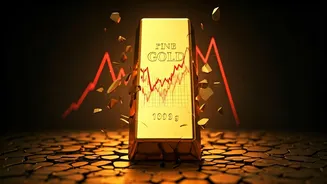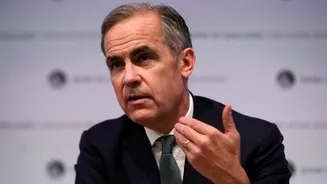Market Shockwaves
Gold prices took a significant hit, plummeting over 6% and approaching $4,000 per ounce, marking the biggest decline in twelve years. Futures contracts
for December delivery (GC=F) dropped by $29.90, or 0.73%, settling at $4,079.20. The spot gold price struggled to stay above the $4,000 threshold. Several factors contributed to this sharp downturn, with the strengthening U.S. Dollar Index (DXY) and diminishing tensions between the U.S. and China playing key roles. The market sentiment shifted towards risk-on, fueled by reports that President Trump would meet with Chinese President Xi Jinping. This improved sentiment dampened the demand for gold, which is typically viewed as a safe-haven asset during times of uncertainty. The market's reaction underscored gold's sensitivity to global economic and political developments.
Factors Behind Crash
Several factors combined to push gold prices downward. Firstly, the strengthening of the U.S. dollar exerted considerable pressure on the metal. Secondly, reports of President Trump's upcoming meeting with Chinese President Xi Jinping in South Korea fueled hopes for a trade agreement, which boosted risk appetite and diverted investors from precious metals. The $4,000 level became a crucial psychological support, with resistance sitting near $4,160–$4,185. A break below $3,947 could lead to a further drop toward $3,838. Despite the recent decline, gold remained above its 100-day EMA, indicating that its long-term uptrend was technically intact. This complex interplay of currency strength, trade optimism, and technical indicators created a volatile environment for gold investors.
Future Price Outlook
Analysts presented various forecasts for gold's future performance. Many predicted a period of consolidation around the $4,000 level, with potential for a rebound supported by geopolitical risks, inflation concerns, and central bank actions. Some projections suggested a rise towards $4,200-$4,400 by the end of 2025, and potentially exceeding $5,000 by the end of the decade if favorable macroeconomic conditions persist. Conversely, a stronger dollar or aggressive Federal Reserve tightening could drive prices lower in the short term. The market's expectation revolved around a degree of volatility driven by Federal Reserve policy shifts and the global economic recovery, which may reduce the demand for safe-haven assets. This highlights the uncertainty that defines the near-term prospects for gold.
Technical Analysis Overview
Technically, the market correction for gold may have begun. The formation of a double-top at $4,380 and the appearance of a bearish engulfing candle on Tuesday signaled a possible reversal. This view was further supported by the rejection near $4,160 during early European trading. Several key support and resistance levels were identified: immediate support at $4,000, next downside target at $3,947, further support at $3,838, and a resistance zone spanning from $4,140 to $4,380. This technical perspective provides crucial reference points for traders navigating the volatile gold market.

















